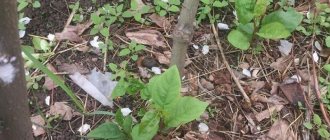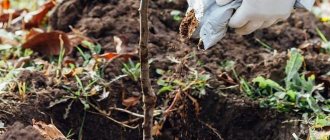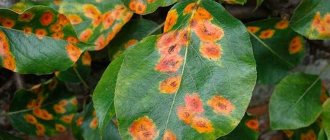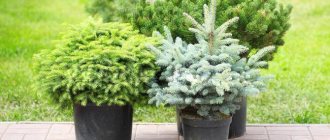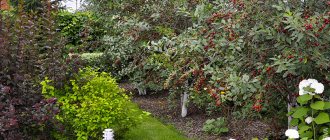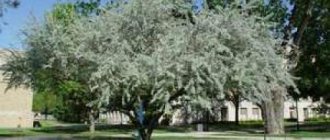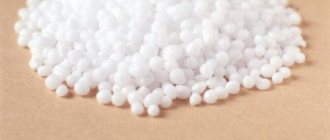Where is the root collar located?
Look carefully at the seedling, find the place where the roots of the plant go into the trunk. But be careful not to confuse the root collar with the grafting site.
Typically, the root collar is located approximately 2-4 cm higher than the uppermost lateral root of the plant. Sometimes it may have some thickening, or it may be completely invisible. This is why gardeners, especially beginners, have difficulties when planting fruit trees, because there is no clear boundary at the root collar.
When is the best time to plant cherries?
Planting dates may vary depending on the climatic conditions of the growing region and the root system of the plant.
If the seedling has a closed root system (CRS), that is, grown in a container, then it can be planted in spring, summer, and autumn, but no later than a month before frost.
It is recommended to plant young trees with an open root system in the middle zone, northern regions, the Urals and Siberia in the spring, when the snow has melted and the earth has warmed up a little and dried out. This usually occurs in early or mid-April. Planting work must be carried out before the buds swell. If a seedling is purchased in the fall, it must be buried before spring, always before frost sets in. This should be done from mid to late September according to the following scheme:
- Place it in a trench about 0.5 m deep at an angle of 30 degrees, directing the crown to the south.
- Cover the roots and trunk with soil up to the 1st side branch.
- Compact the soil and water it.
- Cover the crown with spruce branches. This way the seedlings will be preserved until spring, when it will need to be planted in a permanent place.
In the southern regions, seedlings with an open root system can be planted in spring or autumn.
Planting in autumn is carried out a month before frost - in the second half of September and throughout October
Methods for determining the location of the root collar
In order to more accurately determine the root collar, you can do the following: carefully scrape off the top layer of bark with a knife. If the wood in this place has a greenish color, then this is the trunk of the seedling, and if it is yellowish, then it is the root collar.
However, this method should be used extremely rarely. Because as a result of scraping the bark, young seedlings may die.
You can try to determine the root collar in another way.
You need to take a damp cloth or sponge and wipe the trunk of the plant. In this case, the place where the root collar is located will be visible. Externally, it differs from the trunk of the plant and from the roots . The roots of seedlings usually have a lighter color, yellowish, and the color of the root collar will be closer to brown.
How to choose planting material
Attempts to grow a fruit-bearing cherry tree from a seed or root shoot are likely to end in failure, especially for inexperienced amateur gardeners. The most reliable option is to purchase a grafted seedling from a nursery or garden market. Usually they buy one-year-old or two-year-old trees with mature wood and well-developed roots. You can purchase seedlings with both open and closed root systems.
The range of seedlings is especially wide in the autumn, so it is recommended to buy it during this period. Planting material is selected according to the following external characteristics:
- A healthy young tree has a well-developed root, but few branches.
- The seedling should not have any damage or signs of disease.
- Plant height is approximately 1 m.
- For a two-year-old seedling, the trunk should be about 60 cm in height, the diameter should be at least 2 cm, and the length of the main skeletal branches should be about 60 cm.
In addition to external signs, you need to pay attention to the variety. It is chosen depending on the climatic conditions of the growing region - it must be suitable for them. If the climate is dry, you should choose varieties that tolerate drought well. It is important that cherries are disease resistant.
There is one more selection criterion: some varieties have the appearance of a tree, others have the appearance of a bush.
Correct fit
When planting fruit trees, it is imperative to take into account the location of the root collar. Otherwise, it may turn out that the plants grow poorly or get sick often, or simply do not produce crops for a long time. Therefore, the root collar should be flush with the upper edge of the planting hole. Of course, except in cases where plant growing conditions allow it to be buried.
Advantages and disadvantages of autumn planting
Planting cherries in the fall has the following advantages:
- Planting material is of higher quality than in spring. Seedlings are dug up in the fall, and unsold ones are stored until spring. Even with proper storage, they are inferior in viability to autumn ones, since they experienced stress at this time.
- When planted in autumn, the roots develop quickly in the spring and the cherry tree grows well.
- Less exposure to adverse weather factors if planting is done correctly.
- Plants planted in autumn are about 3 weeks ahead of spring plants in development.
- The planting process is simpler and subsequent maintenance is minimal. In the fall, you only need to plant and cover, while in the spring, regular watering, weeding, fertilizing, and fungicide treatment are required.
- All injuries received during the rest period, which lasts throughout the winter, will heal well.
- It is easier to determine the condition of a seedling by its fresh root system.
Planting cherries with a closed root system
A seedling with a lump of earth can be planted in the summer. The soil requirements are the same as for a bare-root plant.
The best time for planting is warm, humid weather.
Planting process:
- Dig a hole the size of a clod of earth. The graft should be above the soil.
- Carefully remove the film from the ball.
- Gently loosen the earthen lump using a knife, making vertical movements. Proceed carefully so as not to damage the root system. Once the roots are free, they will take root better.
- Place the young tree in the hole so that the most developed branches of the seedling are located on the north side.
- Cover with soil and press down firmly with a shovel.
- Pour water (half a bucket per hole).
- Add soil and tamp down with your foot.
- Mulch with quail manure, leaving about 8 cm from the trunk.
What to do if the apple tree does not bear fruit
Sometimes it happens that a gardener cannot wait for the harvest from his apple trees. There are several reasons for this. Perhaps varietal characteristics or unfavorable weather conditions are to blame for this. But often the careless owner is to blame for the fact that the trees do not want to bear fruit. Simply because he doesn’t care for his garden properly.
Apple tree without fruit.
Frequency of apple tree fruiting
Some varieties differ in periodicity in fruiting, so it is not advisable to wait for an annual harvest. You can only slightly smooth out the difference between a harvest year and a lean year by organizing proper cultivation and nutrition. Among pome trees, the apple tree is the leader in the frequency of fruiting.
Adult apple trees that previously regularly bear fruit, having reached a certain age, switch to periodic fruit ripening. This is due to the depletion of the tree’s vital resources, with the beginning of the process of extinction. In this case, you can try to carry out severe anti-aging pruning of the tree to stimulate the growth of new shoots, as well as carry out maintenance feeding.
Non-fruiting apple tree
An apple tree that does not bear fruit is a big disappointment for a gardener. To avoid such disappointments, you just need to follow a few rules even at the stage of selecting a seedling and planting it in the ground.
If the tree has bloomed profusely, a lot of ovary has appeared, a large number of apples are developing, then the tree no longer has enough strength to lay fruit buds for the next year. As a result, if you get a big harvest this year, be prepared to be left without apples next year.
To avoid the consequences of a bountiful harvest and enjoy the results of annual uniform fruiting, you can teach the tree to independently regulate flowering. In a year of abundant flowering, it is necessary to pick off some of the flowers so that the apple tree has the strength not only to develop fruits, but also to lay buds for the next year.
Varietal feature
Some apple trees have a distinctive feature - irregular fruiting, which is due to the genetic varietal characteristics of the tree. In this case, you can try to correct the frequency of fruiting by regulating flowering, i.e. just pick off excess flowers, leaving no more than 10 flowers on one branch.
Improper pruning and crown formation
Gross violations of the rules for pruning the crown can lead to the fact that the tree stops bearing fruit. This is due to the fact that inexperienced gardeners often cut off not only the growth branches, but also the fruit and flower buds necessary for fruiting. Fruit branches include:
- fruit twig;
- spear;
- ringed;
- fruitfulness;
- fruit bag.
Scheme of correct pruning of an apple tree.
When forming the crown and pruning branches, the following factors should be taken into account:
- a thickened crown does not contribute to good fruiting: the fruits grow small, tasteless, and poorly colored;
- On vertically located branches you will have to wait a very long time for fruiting. The best arrangement of fruit branches is considered to be a straight or slight angle with respect to the trunk.
How to overcome fruiting problems
To correct the situation and achieve fruiting, you can take several measures, depending on the identified cause.
Correct the situation on the spot and wait
- If groundwater is close to the ground or water stagnates after snow melts, you can try to install a drainage system on the site. This will eliminate oversaturation of the soil with moisture.
- If there is a lack of nutrients in the soil, it is necessary to carry out regular balanced fertilizing with organic matter and mineral fertilizers.
It is imperative to monitor the frequency of application of nitrogenous fertilizers, the excess of which provokes the tree to become fattened. - If there is a violation during planting of the seedling and the root collar is too deep, you can simply wait another year or two.
Such trees subsequently become stronger than their counterparts planted according to the rules. Although later than others, the apple tree will bear fruit.
Replant an apple tree
If the wrong place for planting the apple tree is chosen, you will have to carefully move it to a more suitable place. This is not easy to do, taking into account the fact that by the time fruiting begins, the apple tree reaches an impressive size, and its root system is already formed.
Apple tree transplant.
If you cannot do without a transplant, then you need to carefully select a place and perform the transplant, observing all the rules and precautions.
Creating conditions for pollination
Many varieties need pollinators. If possible, when planting apple trees, you need to select varieties so that they are suitable cross-pollinators for each other. To do this, they must have the same flowering time.
If it is not possible to plant several apple trees, then you will have to get out of the situation in other ways:
- you can graft a branch of a variety suitable for the role of a pollinator into the crown;
- During flowering, bring flowering twigs of a suitable variety to the site and leave them for several days next to the flowering apple tree, having previously provided the cut branches with moisture.
The site must have honey plants that will attract the attention of pollinating insects.
Prevention and advice from gardeners
Preventive measures should be carried out every growing season, depending on the time of year. Experienced gardeners are developing a system of measures aimed at improving fruiting. This includes regular feeding of trees, treatment against diseases and pests.
In addition to traditional methods of increasing productivity, gardeners use scientifically unsubstantiated, but no less effective methods. For example, many amateur gardeners recommend adhering to lunar rhythms when planting apple tree seedlings. So it is believed that the apple tree needs to be planted in a permanent place a couple of days before the new moon.
Another interesting folk method of obtaining a harvest: the method of intimidation. You need to take an ax, go up to the apple tree and threaten to cut it down if it doesn’t produce a harvest. Many gardeners note the success of this method and advise others to try it.
Conclusion
By providing apple trees with proper care in compliance with the rules of agricultural technology during planting, pruning and crown formation, systematic balanced fertilizing, mandatory water-replenishing watering, preventive measures to combat diseases and pests, you can achieve regular fruiting and extend the life of the trees.
PreviousNext
Source: https://NaYablone.ru/polezno/ne-plodonosit-yablonya
Planting an apple tree: how to do it correctly? Tips from Mikhail Chertok on Supersadovnik.ru
A young fruit tree does not want to bear fruit, blooms late in the spring, or feels unwell? It is important not only to choose the right variety and quality variety. but also to plant an apple tree correctly
Usually, when buying seedlings, the seller explains with reason where the grafting site is on the seedling, how to dig a hole and plant the plant. But most sellers simply memorize recommendations and then unwittingly distort them. Hence the mistakes, due to which the seedlings get sick for a long time, do not begin to bear fruit soon, and sometimes die.
Planting an apple tree in the garden in spring
Even seedlings of winter-hardy fruit varieties, if they are grown in southern nurseries, are poorly adapted to the climate of the middle zone. Therefore, choose nurseries located close to your site to purchase planting material. Try to buy seedlings from the manufacturer, and not from a reseller.
Features of the structure of an apple tree seedling
Let's consider the structure of a grafted fruit seedling. Its root system is separated from the stem by a root collar. It is important to find the root collar correctly: this is the place where the first large lateral root emerges. The grafting can be done on the standard (stem of the rootstock) or in the root collar. Therefore, when planting, they focus not on the grafting, but on the root collar.
Preparing a planting hole for planting an apple tree
Dig a hole with a diameter of about 80 cm and a depth of 80–90 cm. To fill it, you will need peat and rotted manure (2 wheelbarrows each), sand (if the soil is heavy) and complex mineral fertilizers. Before filling, drive a garter stake into the bottom of the hole in the center.
Fill in layers: pour peat, soil, humus and a handful of complex mineral fertilizers into a wheelbarrow, mix thoroughly. Repeat everything in the same order until a mound 15–20 cm high is formed above the hole. This is necessary: loose soil in the hole will shrink by about 10%, and the height of the mound will decrease by 10 cm.
If you fill the hole level with the ground, the seedling will end up in a depression, water will accumulate around it, which creates a threat of rotting of the bark.
Around a mound with a diameter slightly larger than the diameter of the hole, form a roller that retains water when watering.
Planting an apple tree seedling
To plant at the top of the mound, make a depression slightly larger than the root system of the seedling.
Straighten the roots and carefully cover them with soil, while the root collar should be raised above the ground by 5–7 cm, and the roots should be directed to the sides and down and covered with soil. Before watering, trample the soil around the seedling with your foot, placing the toe of the shoe against the stem of the seedling.
The stem is tied to a stake in a figure eight: the loops of the tie should be loose and only support the seedling in an upright position. If the bases of the roots end up above the ground, it’s okay. During the process of soil shrinkage, the seedling will be pulled into the ground, and the root collar will be at ground level. But even if this does not happen, you can always add soil to cover the roots.
After planting, water the seedling with a weak stream from a watering can or hose so that the mound is not washed away and the roots are not exposed. One plant needs at least 4 buckets of water.
Pruning a young apple tree seedling
Sometimes after winter the top of a young tree dries out by 5–7 cm due to the fact that the annual growth does not have time to fully prepare for winter. This often happens in the first year after planting, especially in the fall. To avoid this, when planting a seedling in the fall, its top is cut off to mature wood.
It can be determined by the length of the internodes and the color of the bark. On the unripe part of the shoot, the traces of leaf attachment are very close together, and the bark is covered with gray or greenish fluff - in contrast to the glossy bark of the mature part of the shoot.
But even if you are not sure that you have correctly distinguished the mature part of the shoot from the unripe one, you can simply prune the seedling by 2-3 buds immediately after planting.
At the same time, the existing side branches also need to be shortened so that they are not higher than the central conductor.
What to do if an apple tree seedling is buried?
Gardeners often complain about the death of seedlings in winter. This can happen for various reasons. Firstly, the seedlings themselves may not be winter-hardy enough. Secondly, the cause of freezing may be weakening of the tree due to improper planting.
If the root collar was buried, the tree, instead of developing a root system and settling into a new place, struggled for survival and did not have time to prepare for winter.
Sometimes a tree grows for 10 or more years and does not bear fruit. Gardeners are starting to think about getting rid of it or stimulating it to bear fruit. But the reason may lie in the depth of the seedling. Rake the soil away from the trunk and find the root collar. If it is below the soil level, dig up the plant and lift it along with a lump of earth to the desired height.
Illustrations for the material: Shutterstock/TASS, drawings: Mikhail Chertok
Source: https://www.supersadovnik.ru/text/posadka-dereva-kak-pravilno-1003942
